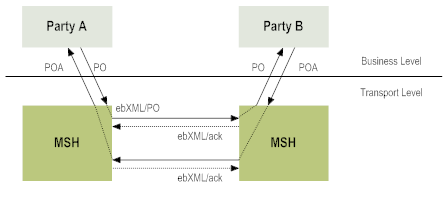Introduction
webMethods ebXML Module is based on the electronic business XML (ebXML) specification that enables enterprises of any size and in any geographical location to conduct business over the Internet. Using ebXML, organizations have a standard method to exchange business messages, conduct trading relationships, communicate data in common terms, and define and register business processes.
webMethods ebXML Module 7.1 SP1 is an implementation of the ebXML Message Service Version 1.0 Specification and ebXML Message Service Version 2.0 Specification. webMethods ebXML Module runs on webMethods Integration Server and webMethods Trading Networks. webMethods Trading Networks enables enterprises to link with other organizations to enable a secure business-to-business trading network.
The ebXML Message Service Version 1.0 Specification and ebXML Message Service Version 2.0 Specification provide a reliable and secure delivery infrastructure for exchanging electronic business documents of any format that is independent of your communications protocol.
A typical example of an ebXML exchange might be two trading partners (Party A and Party B) exchanging a purchase order (PO) and purchase order acknowledgment (POA) via the ebXML Message Service. This illustration refers to a message receiver or sender at the transport level as a Message Service Handler (MSH).
Party A submits a PO to its MSH. The MSH for Party A wraps the PO within an ebXML envelope and sends it to Party B. The MSH for Party B receives the message and sends back a transport level acknowledgment to the MSH for Party A. Then, the MSH for Party B forwards the PO to Party B.
After processing the PO, Party B creates a POA and submits it to its MSH. The MSH for Party B wraps the POA within an ebXML envelope and sends it over to Party A. The MSH for Party A receives the message and sends back a transport level acknowledgment to the MSH for Party B. Then, the MSH for Party A forwards the POA to Party A.
As illustrated in the following figure, a clear separation exists between the business level and the transport level. The ebXML Message Service is involved in transport-level communication.
Example exchange between two trading partners using the ebXML Message Service Protocol

